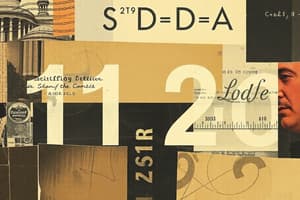Podcast
Questions and Answers
What is the principle that dictates that no two electrons in an atom can have the same set of quantum numbers?
What is the principle that dictates that no two electrons in an atom can have the same set of quantum numbers?
- Aufbau Principle
- Octet Rule
- Hund's Rule
- Pauli's Exclusion Principle (correct)
Which of these statements about ionic bonding is true?
Which of these statements about ionic bonding is true?
- Ionic compounds consist of cations and anions. (correct)
- Ionic bonds are formed only between non-metals.
- Ionic bonds involve the sharing of electrons.
- Ionic bonds are weaker than covalent bonds.
How are elements in the periodic table primarily arranged?
How are elements in the periodic table primarily arranged?
- By increasing atomic number (correct)
- By their chemical properties
- By electron configuration
- By atomic mass
What does the atomic radius tend to do as you move across a period in the periodic table?
What does the atomic radius tend to do as you move across a period in the periodic table?
Which type of bonding involves the complete transfer of electrons from one atom to another?
Which type of bonding involves the complete transfer of electrons from one atom to another?
What shape does an s orbital have?
What shape does an s orbital have?
In terms of wave properties, what does 'wavelength' refer to?
In terms of wave properties, what does 'wavelength' refer to?
Which of the following statements accurately describes covalent bonding?
Which of the following statements accurately describes covalent bonding?
What is the primary purpose of using scientific notation?
What is the primary purpose of using scientific notation?
Which of the following correctly describes pure substances?
Which of the following correctly describes pure substances?
What does the kinetic molecular theory suggest about the particles in a gas?
What does the kinetic molecular theory suggest about the particles in a gas?
How can the atomic number of an element be defined?
How can the atomic number of an element be defined?
What is an isotope?
What is an isotope?
In which phase of matter are the particles arranged in a highly ordered structure?
In which phase of matter are the particles arranged in a highly ordered structure?
Which of the following statements about metric conversion is true?
Which of the following statements about metric conversion is true?
What is the significance of drawing and interpreting graphs in scientific research?
What is the significance of drawing and interpreting graphs in scientific research?
Flashcards are hidden until you start studying
Study Notes
Scientific Skills & Notation
- Rounding off numbers to a specified number of digits is essential for precision.
- Powers of 10 and exponent laws are fundamental to understanding scientific notation.
- Scientific notation is used for expressing very large or small numbers in a compact form.
- Practice conversions between standard form and scientific notation with or without calculators.
- Familiarity with SI symbols and units is crucial for scientific communication.
- Ability to convert units into SI units, using common conversion factors in mass, length, volume, temperature, and pressure.
- Recognizing and converting various metric scales aids in accurate measurements.
- Orders of magnitude help understand the scale of differences between quantities.
- Mathematical manipulations and equations are vital for scientific analysis.
- Understanding the scientific method involves variables, data collection, and hypothesis testing.
- Proficient use of tables and graphs enhances data interpretation.
- Direct and inverse relationships in graphs show how variables are related.
Classification of Matter & Kinetic Molecular Theory
- Matter is classified into mixtures (homogeneous and heterogeneous) and pure substances (elements and compounds).
- Familiarity with names and formulas of substances is necessary.
- Kinetic Molecular Theory (KMT) describes all matter as composed of tiny particles (atoms and molecules) that are too small to see.
- Matter exists in five phases, with each phase having different particle arrangements.
- Phase changes such as melting and boiling are defined by specific temperatures.
The Atom
- Atomic models have evolved through key discoveries, influenced by five major contributors.
- Atoms consist of protons, neutrons, and electrons.
- The atomic number of an element indicates the number of protons; neutral atoms have equal protons and electrons.
- Neutron number is calculated by subtracting the atomic number from the mass number.
- Isotopes are variants of elements with the same number of protons but differing neutron counts.
- Nuclei can be represented in the notation [
Z^A^E]. - Electron configurations describe how electrons are arranged in atomic orbitals, following the Aufbau principle, Hund's rule, and Pauli's Exclusion Principle.
Periodic Table
- The periodic table arranges elements in ascending atomic number, reflecting electron configurations.
- Understanding the arrangement clarifies group and period numbers, valence electrons, and valency.
- Periodic trends include atomic radius, ionization energy, electron affinity, and electronegativity.
Chemical Bonding & Equation Writing
- Covalent bonding involves sharing electrons, forming single, double, or triple bonds; molecular formulas and electron diagrams represent these compounds.
- Ionic bonding relies on electron transfer, creating cations and anions, with specific naming conventions for ionic compounds.
- The structure of ionic crystals is based on ionic bonding principles and results in the formation of salts.
- Metallic bonding is characterized by a 'sea of electrons' contributing to properties like conductivity.
- Writing balanced chemical equations is essential, representing conservation of atoms and relative atomic masses.
- Word equations must be translated into chemical equations for clarity, using symbols to indicate phases (s), (ℓ), (g), and (aq).
Waves Basics
- Transverse waves consist of alternating crests and troughs, with definitions for wavelength, frequency, amplitude, and period.
- Wave speed is determined by the relationship between frequency and wavelength.
- Concepts of "in phase" and "out of phase" describe the alignment of waveforms in a wave system.
Studying That Suits You
Use AI to generate personalized quizzes and flashcards to suit your learning preferences.




